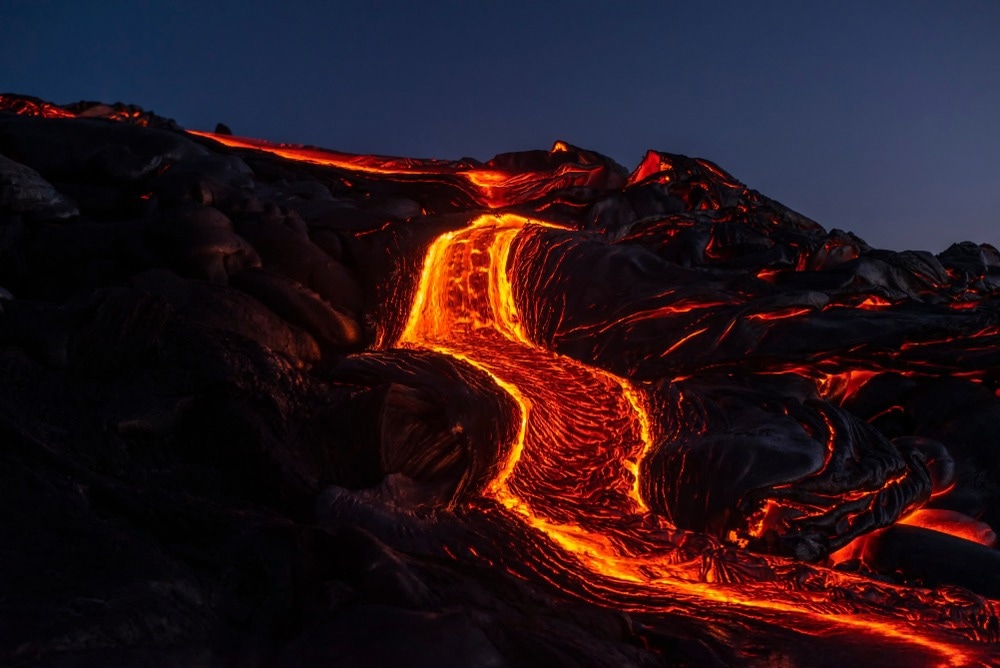The latest study published in the Journal of Volcanology and Geothermal Research aims to enhance comprehension of spectral emissivity by studying its relationship with the temperature of 3 different basalts.

Study: High-temperature spectral emissivity of glass and crystal-bearing basalts. Image Credit: Yvonne Baur/Shutterstock.com
Lava Flow Temperature - An Essential Basaltic Parameter
A major risk associated with exuberant basaltic volcanism is lava flows. Constant lava flow monitoring and precise ground evolutionary modeling are essential for estimating the lava flows' probable run-out distance and reducing their influence on nearby areas. Since it significantly affects the rheological characteristics of the advancing lava flow, the temperature is one of the crucial variables that must be accurately determined.
Lava Flow Temperature Measurement
Thermocouples can be used to detect volcanic temperature locally, or remote sensing (RS) tools can be used to monitor it remotely.
Lava flows are more frequently monitored by ground-, air-, and satellite-based remote sensing techniques owing to the limited generalization and geographical penetration of local techniques and the unpredictable behavior of volcanoes. These remote methods assess the lava body's emission flux (radiance) at several wavelength bands, and this is used to find the temperature using Planck's law.
Limitations of Lava Temperature Measuring Techniques
However, even tried-and-true methods have preconceptions and restrictions that can cause significant mistakes in observations. The varying surroundings and the ongoing variations in the temperature, makeup, and viscosity of the cooling lava can all influence measurements.
The fluctuation of lava flow radiative characteristics with temperature is currently poorly known; thus, even if the errors of ambient and geothermal variations may be decreased, quantifying emission flux and predicting temperature is difficult. As a result, the radiative characteristics of lava seem to be the biggest cause of temperature retrieval error.
Aim of the Study
This study aims to reduce the ambiguity in spectroscopic emissivity (e). This value is essential for retrieving the temperature of the lava flow from its emission flux using remotely observed data. To accomplish this, a direct IR emissivity measurement device was used to track the changes in the radiative characteristics of 3 distinct basaltic compositions across a wide temperature range.
What is Spectral Emissivity?
The ability of a substance to physically release thermal radiation, such as a lava flow, is known as its spectral emissivity.
The gradual chilling and precipitation of an expanding lava flow must lead to the continual evolution of its radiation characteristics because the chemistry and crystal concentration of magma are greatly influenced by temperatures. Therefore, a detailed understanding of the lava spectral emissivity is required to obtain more accurate temperature estimates utilizing remote sensing data.
Importance of Radiative Properties
An object's radiation characteristics evaluated in the opaque region (TIR) are solely indicative of its surface. Contrarily, the radiative characteristics captured in the electrical and multiphonon areas (i.e., the MIR and SWIR domains) are specific to the tested volume and rely on optic depth before being influenced by an object absorption coefficient.
Specimen Characterization
Basaltic in nature, the magma from the Holuhraun eruption contains 2.73 wt% alkalis and 48.91 wt% SiO2. The Juan de Fuca mid-oceanic ridge basalt, often known as MORB, has an extremely fine-grained structure. Components of the Fasnia volcano can be categorized as basanitic in structure.
Research Findings
The ε minimum at 980 cm-1 marginally improves from 0.79 to 0.82 with the temperature rise (from 520 K to 1020 K), which is the anticipated development with temperature. The ε increases significantly with temperatures between 1020 and 1097 K above the glass transition temperature (from 0.94 close to unity at 2400 cm-1), blurring the transmissivity edge. This sudden increase in the multiphonon and electronic regions is associated with the opacification process.
The temperature range at which the opacification phenomena is initiated, and consequently when the refractive indices switch from semi-transparent to opaque, is connected to the primary variation between their radiative behaviors. According to all experimental evaluations, starting B-glass is crystal-free and uniform.
Although it is still challenging to measure the spectral emissivity of fully molten igneous rocks, this work must be conducted as it is vital for the study of volcanoes and geothermal energy.
Further Reading
J. Biren et al. (2022). High-temperature spectral emissivity of glass and crystal-bearing basalts, Journal of Volcanology and Geothermal Research. Available at: https://www.sciencedirect.com/science/article/pii/S0377027322001548?via%3Dihub
Disclaimer: The views expressed here are those of the author expressed in their private capacity and do not necessarily represent the views of AZoM.com Limited T/A AZoNetwork the owner and operator of this website. This disclaimer forms part of the Terms and conditions of use of this website.